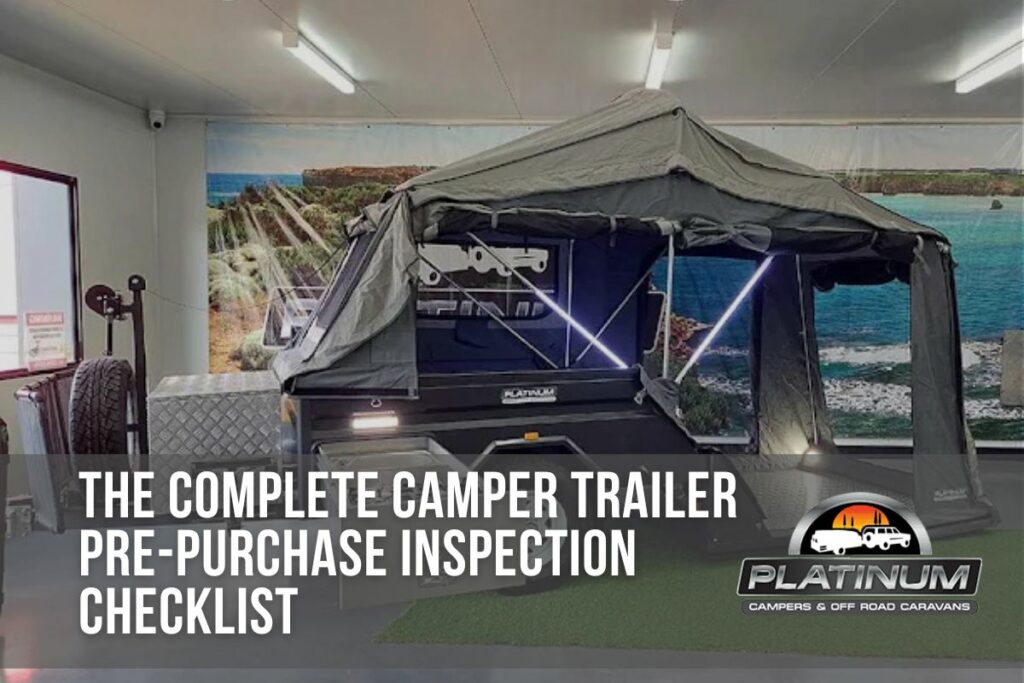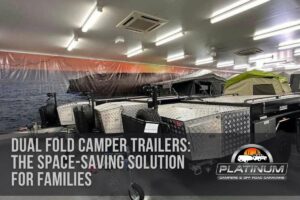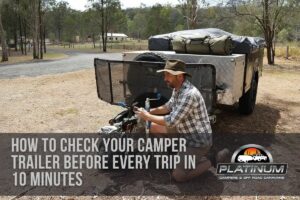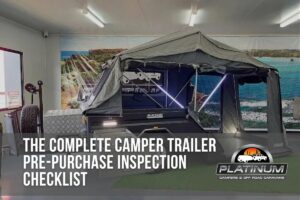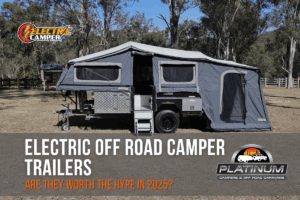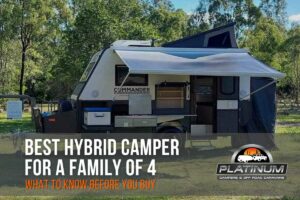Introduction
Purchasing a camper trailer is an exciting step toward countless Australian adventures, but it requires careful inspection to ensure you’re investing in quality, safety, and reliability. Whether you’re considering a brand-new Platinum Campers model or evaluating a used trailer, a thorough pre-purchase inspection protects your investment and ensures years of worry-free camping. This comprehensive checklist covers every critical component, from chassis integrity to electrical systems, helping both first-time buyers and experienced campers make informed decisions.
Overview
This guide provides a systematic approach to inspecting camper trailers before purchase. You’ll learn how to evaluate structural integrity, mechanical components, safety systems, and interior features. The checklist format makes it easy to follow during your inspection, ensuring nothing important is overlooked. We’ll also cover red flags to avoid and questions to ask dealers or private sellers.
Key Takeaways
• Always inspect the chassis, suspension, and coupling system for wear and damage
• Check electrical systems, brakes, and lights for proper functionality
• Examine canvas and seals for deterioration, mold, or repair patches
• Verify all appliances, water systems, and gas connections work correctly
• Document any issues and factor repair costs into your purchase decision
• Understand warranty coverage and after-sales support options
Pre-Inspection Preparation
Before beginning your inspection, gather essential tools and information to conduct a thorough evaluation. Proper preparation ensures you can identify potential issues and make an informed purchasing decision.
Essential Tools for Inspection
Bring a flashlight or headlamp for examining dark spaces, a multimeter for testing electrical connections, and measuring tape for verifying dimensions. Pack work gloves for safety when handling components, and consider bringing a magnet to test for steel versus aluminum construction. A smartphone camera helps document any concerns for later review.
Research the Model
Investigate the specific camper model’s reputation, common issues, and typical pricing before your inspection. Check online forums and reviews for known problems with that particular model or manufacturer. Understanding the trailer’s original specifications helps identify modifications or missing components during your inspection. Our camper trailers buyers guide provides valuable insights into what to look for in different types of campers.
Pre-Inspection Checklist
☐ Research model specifications and common issues
☐ Gather inspection tools (flashlight, multimeter, measuring tape)
☐ Prepare questions about warranty, service history, and inclusions
☐ Set realistic budget including potential repair costs
☐ Arrange proper lighting for thorough inspection
Structural and Chassis Inspection
The foundation of any reliable camper trailer lies in its structural integrity. A thorough examination of the chassis, frame, and mounting points reveals the trailer’s overall condition and potential longevity.
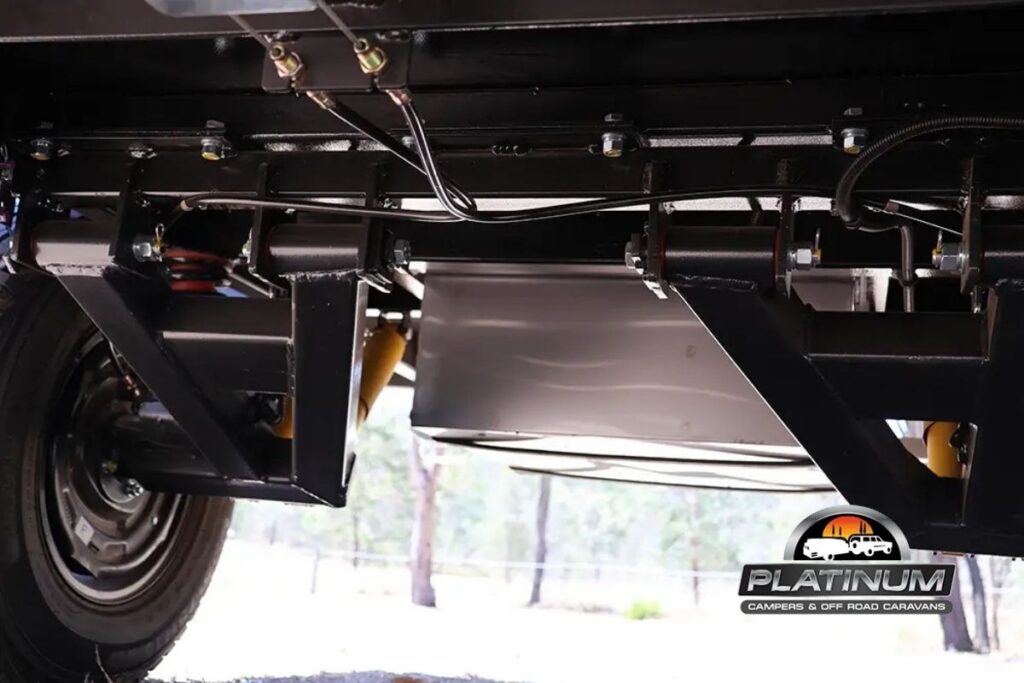
Chassis and Frame Assessment
Examine the main chassis rails for cracks, rust, or previous repair work. Look for straight, solid construction without significant corrosion or damage. Check all mounting points where components attach to the frame, ensuring bolts are tight and mounting brackets show no signs of stress or failure.
Inspect the drawbar and A-frame construction for proper alignment and structural soundness. Any bending, cracking, or welding repairs in these critical areas should raise immediate concerns about the trailer’s safety and roadworthiness.
Suspension System Evaluation
Test the independent suspension by pushing down on each corner of the trailer, checking for proper spring response and smooth operation. Examine shock absorbers for leaks, damage, or excessive wear. Verify that suspension components move freely without binding or unusual noises.
Check wheel bearings by grasping each wheel and attempting to rock it horizontally and vertically. Excessive play indicates bearing wear that requires immediate attention. Inspect CV joints and drive components for signs of wear or damage.
Structural Inspection Checklist
☐ Chassis rails free from cracks, rust, or damage
☐ All mounting points secure with tight bolts
☐ Drawbar and A-frame properly aligned and solid
☐ Suspension operates smoothly without binding
☐ Shock absorbers show no leaks or damage
☐ Wheel bearings have minimal play
☐ CV joints and drive components in good condition
☐ No signs of accident damage or major repairs
Coupling and Towing System
The coupling system represents your primary connection between vehicle and trailer, making its inspection absolutely critical for safe towing. Proper functionality and maintenance of these components ensures secure attachment and reliable performance on Australian roads.

Coupling Mechanism Inspection
Examine the coupling head for smooth operation, proper locking mechanism function, and absence of excessive wear. The coupling should engage and disengage easily while maintaining a secure connection. Check for cracks, distortion, or excessive play in the coupling components.
Inspect the safety chains and their attachment points for proper rating, secure mounting, and absence of damage. Verify that chains are the correct length and rating for your trailer’s weight. Test the breakaway cable and ensure it’s properly connected to the handbrake system.
Jockey Wheel and Stabilizer Assessment
Test the jockey wheel for smooth operation, proper support capacity, and secure locking mechanisms. The wheel should raise and lower the trailer easily while maintaining stability. Check for bent components, damaged threading, or inadequate load capacity. Our guide on upgraded jockey wheel hitch explains the importance of quality hitching systems.
Examine corner stabilizer legs for proper operation, adequate support, and secure mounting. Each stabilizer should extend and retract smoothly while providing solid support when deployed. Look for bent legs, damaged mounts, or inadequate ground contact pads. Read our tips for using and maintaining your stabiliser legs for proper maintenance guidance.
Coupling System Checklist
☐ Coupling head operates smoothly and locks securely
☐ Safety chains properly rated and securely mounted
☐ Breakaway cable connected and functional
☐ Jockey wheel operates smoothly with secure locking
☐ Corner stabilizers extend/retract properly
☐ All mounting hardware tight and undamaged
☐ Load ratings appropriate for trailer weight
☐ No signs of excessive wear or damage
Electrical and Lighting Systems
Reliable electrical systems ensure safe road travel and proper operation of essential trailer functions. A comprehensive electrical inspection prevents dangerous situations and costly repairs down the road.

Lighting System Verification
Test all external lights including indicators, brake lights, tail lights, and reverse lights if equipped. Each light should illuminate brightly and consistently without flickering or dim spots. Check for proper lens condition, secure mounting, and water-tight seals.
Examine the wiring harness for damage, corrosion, or amateur repairs. Look for exposed wires, corroded connections, or inappropriate splicing that could cause electrical failures. Verify that the plug connection matches your vehicle’s socket and operates correctly.
Interior Electrical Assessment
Test all 12V outlets, LED lights, and electrical accessories for proper operation. Check battery charging systems, solar panel connections if equipped, and any inverter installations. Verify that circuit protection devices like fuses and circuit breakers are properly rated and functional. Our comprehensive guide on maximizing your camper trailer’s 12V system with Anderson plugs provides detailed information about electrical systems.
Inspect the main electrical panel for proper labeling, secure connections, and appropriate circuit protection. All electrical modifications should appear professional with proper materials and installation techniques.
Electrical System Checklist
☐ All external lights function correctly
☐ Wiring harness undamaged with secure connections
☐ Plug connector matches vehicle and operates properly
☐ All 12V outlets and interior lights functional
☐ Battery charging system operates correctly
☐ Solar panel connections secure (if equipped)
☐ Electrical panel properly labeled with appropriate protection
☐ No amateur wiring modifications or repairs
Brake System Inspection
Proper brake function is essential for safe towing, especially when navigating steep terrain or emergency situations. A thorough brake inspection ensures reliable stopping power and compliance with Australian road regulations.
Electric Brake Assessment
Test electric brakes using your vehicle’s brake controller to verify proper engagement and release. Brakes should engage smoothly without grabbing or uneven operation. Listen for unusual noises that might indicate worn components or adjustment issues. Our detailed brake controller setup guide explains proper installation and testing procedures.
Inspect brake shoes, drums, and adjustment mechanisms for wear and proper operation. Check for adequate lining material, even wear patterns, and proper clearances. Examine brake wiring for damage, corrosion, or loose connections that could affect performance.
Hydraulic System Evaluation (if equipped)
For hydraulic brake systems, check fluid levels, line condition, and actuator operation. Brake fluid should be clean and at proper levels with no signs of leaks or contamination. Test the breakaway system to ensure proper activation and sufficient stopping power.
Inspect brake lines for damage, corrosion, or inappropriate repairs. All connections should be secure with proper fittings and no signs of fluid leakage.
Brake System Checklist
☐ Electric brakes engage and release smoothly
☐ Brake controller operates correctly
☐ Brake shoes show adequate lining material
☐ Drums free from scoring or excessive wear
☐ Brake wiring secure without damage
☐ Hydraulic fluid clean and at proper level (if equipped)
☐ No brake fluid leaks anywhere in system
☐ Breakaway system activates properly
Wheels, Tires, and Running Gear
The wheels and tires are your trailer’s contact with the road, making their condition critical for safe travel. Proper inspection reveals potential safety issues and helps estimate replacement costs.
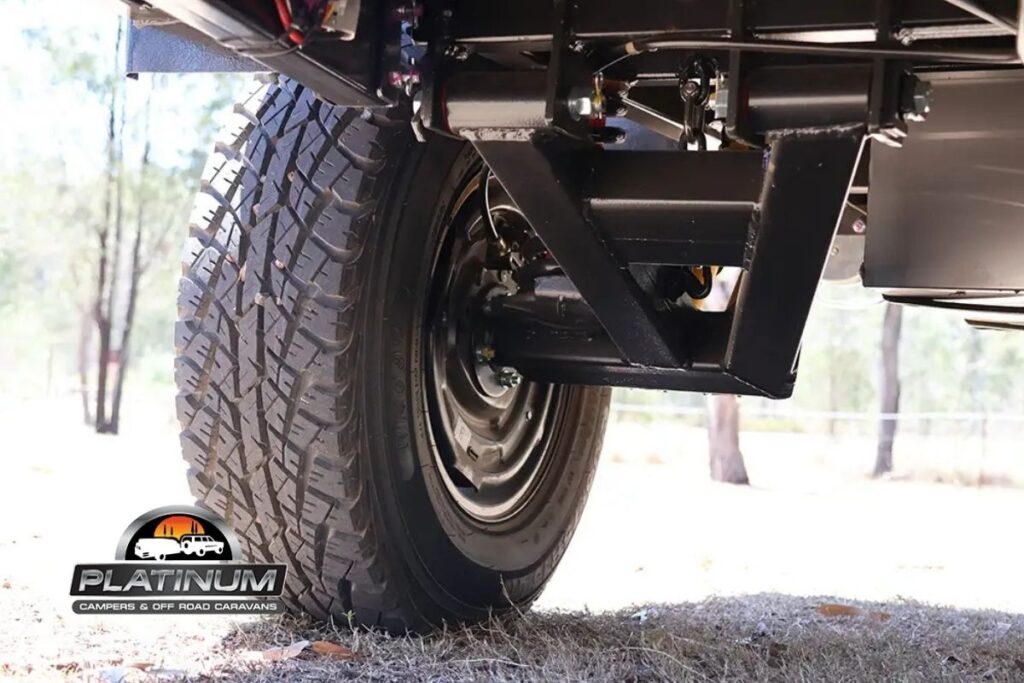
Tire Condition Assessment
Examine each tire for adequate tread depth, even wear patterns, and absence of damage like cuts, bulges, or embedded objects. Check tire age using the DOT date code and consider replacement if tires are over five years old regardless of tread condition.
Verify that tire sizes and load ratings are appropriate for the trailer’s weight and intended use. Mismatched tires or inadequate load ratings can lead to dangerous failures during travel. Understanding camper trailer weights and towing capacity helps ensure proper tire selection.
Wheel and Hub Inspection
Inspect wheels for cracks, bent rims, or loose lug nuts. Check that wheels are properly centered and show no signs of damage from impact or overloading. Examine wheel studs and nuts for proper thread condition and torque specifications. Our importance of wheel nut tensioning article explains proper maintenance procedures.
Check hub assemblies for proper bearing adjustment, grease condition, and seal integrity. Spin each wheel to listen for bearing noise or roughness that indicates maintenance needs.
Wheel and Tire Checklist
☐ All tires show adequate tread depth
☐ Tire wear patterns even across all tires
☐ No cuts, bulges, or embedded objects in tires
☐ Tire ages within acceptable limits (under 5 years)
☐ Tire sizes and load ratings appropriate
☐ Wheels free from cracks or damage
☐ Lug nuts tight with proper torque
☐ Wheel bearings operate smoothly without noise
☐ Hub seals intact without grease leaks
Canvas and Soft Furnishings
The canvas and soft furnishings significantly impact comfort and weather protection during camping. Their condition affects both enjoyment and ongoing maintenance costs.
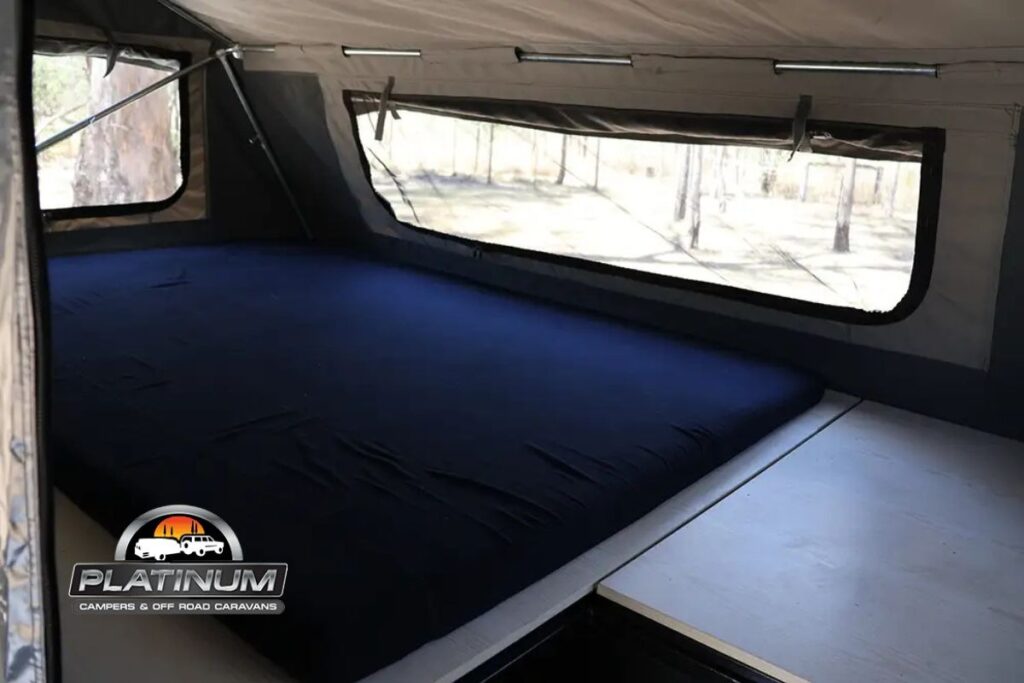
Canvas Quality and Condition
Examine the main tent canvas for tears, patches, or areas of deterioration. Look for signs of mold, mildew, or water damage that could indicate poor storage or maintenance. Check seam integrity and ensure all zippers operate smoothly. Our guide on long-term camper trailer canvas maintenance provides essential care information.
Test canvas tension and attachment systems to verify proper setup and secure mounting. Examine any clear windows for clarity, damage, or UV deterioration that affects visibility and weatherproofing. For cleaning guidance, refer to our article on how to clean camper trailer canvas.
Mattress and Cushion Assessment
Inspect all mattresses and cushions for comfort, support, and cleanliness. Look for signs of moisture damage, mold, or excessive wear that would require replacement. Check that cushion covers are removable for cleaning and in good condition.
Verify that sleeping arrangements match your needs and that all components fit properly within the trailer’s configuration. Consider whether the layout suits your family camping needs.
Canvas and Furnishing Checklist
☐ Canvas free from tears, patches, or deterioration
☐ No signs of mold, mildew, or water damage
☐ All zippers operate smoothly
☐ Canvas attachment systems secure and functional
☐ Clear windows clear and undamaged
☐ Mattresses comfortable with adequate support
☐ Cushions clean without moisture damage
☐ All fabric components removable for cleaning
Appliances and Equipment
Built-in appliances and equipment add convenience to your camping experience but require inspection to ensure proper operation and safety. Faulty appliances can be expensive to repair or replace.
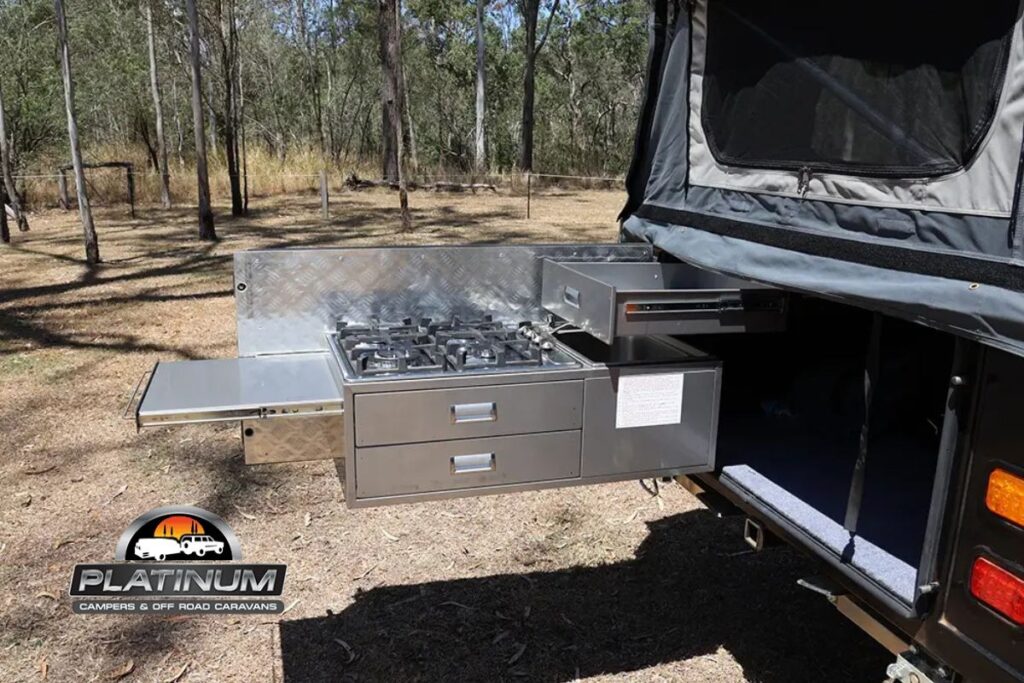
Kitchen Appliance Testing
Test all kitchen appliances including stoves, grills, and refrigeration units for proper operation. Check gas connections for leaks using soapy water and verify that all safety shut-offs function correctly. Examine exhaust systems and ventilation for proper operation. Our gas stove setup guide provides safety information for gas appliances.
Verify that electrical appliances operate correctly on both 12V and 240V power sources where applicable. Test all controls, thermostats, and safety features to ensure proper functionality.
Water System Evaluation
Test the water system including pumps, tanks, and all faucets for proper operation and adequate pressure. Check for leaks in plumbing connections and verify that all taps and valves operate smoothly. Examine the hot water system if equipped and test for proper heating and temperature control.
Inspect grey and black water systems for proper operation, secure connections, and absence of odors or leaks.
Appliance and Equipment Checklist
☐ All gas appliances operate correctly and safely
☐ No gas leaks detected at any connections
☐ Electrical appliances function on appropriate power sources
☐ Water pump operates with adequate pressure
☐ All taps and valves operate smoothly
☐ Hot water system heats properly (if equipped)
☐ No water leaks in plumbing system
☐ Waste water systems operate without odors or leaks
Interior Layout and Storage
The interior layout and storage capacity significantly impact your camping comfort and organization. Evaluate these features based on your specific camping needs and family size.
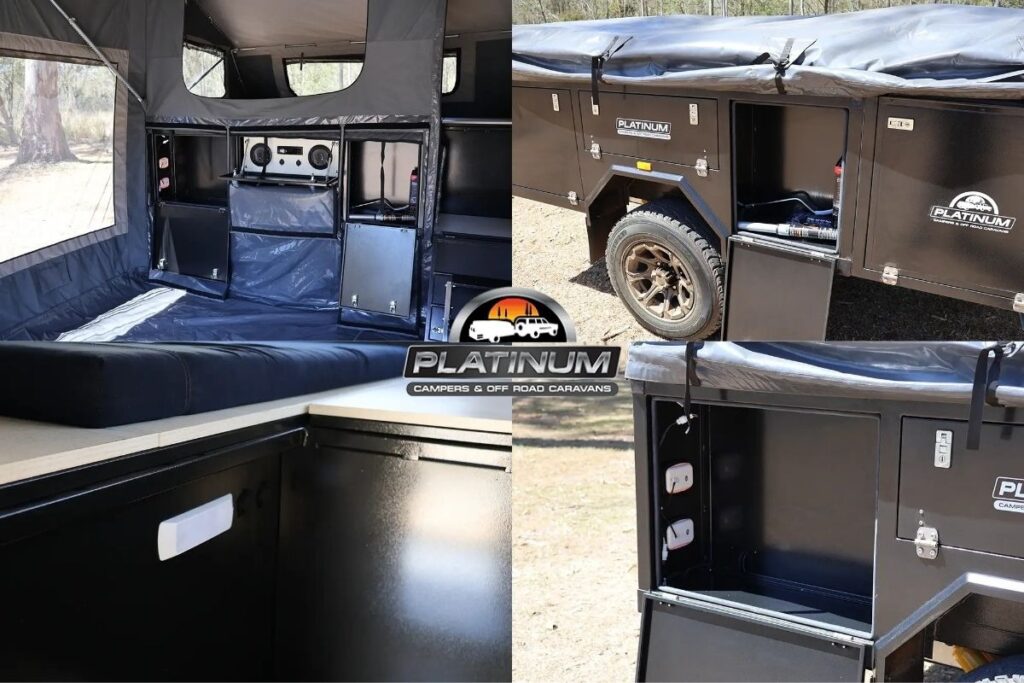
Space Utilization Assessment
Examine the interior layout for efficient use of space and suitability for your camping style. Check that sleeping arrangements accommodate your group size comfortably. Verify that the dining area provides adequate seating and table space for meals and activities.
Test all fold-out beds, convertible seating, and space-saving features for ease of operation and structural integrity. Ensure that setup and pack-down procedures are manageable for your physical capabilities. Consider reading about the best family camper trailers to understand different layout options.
Storage Capacity Evaluation
Inspect all storage compartments for adequate space, secure latching, and weather protection. Check that internal storage includes appropriate organization for camping gear, clothing, and supplies. Examine external storage boxes for security, weatherproofing, and ease of access. Our creative camper trailer storage ideas article offers practical organization tips.
Verify that storage compartments can accommodate your typical camping equipment and that weight distribution works properly with your loading requirements.
Interior and Storage Checklist
☐ Interior layout suitable for your group size
☐ Sleeping arrangements adequate and comfortable
☐ Dining area provides sufficient space
☐ All fold-out features operate smoothly
☐ Setup procedures manageable for your abilities
☐ Storage compartments secure and weather-tight
☐ Adequate storage for your camping equipment
☐ External storage accessible and secure
Safety and Compliance Features
Safety features and regulatory compliance protect your family and ensure legal operation on Australian roads. These systems require careful inspection to verify proper installation and operation.
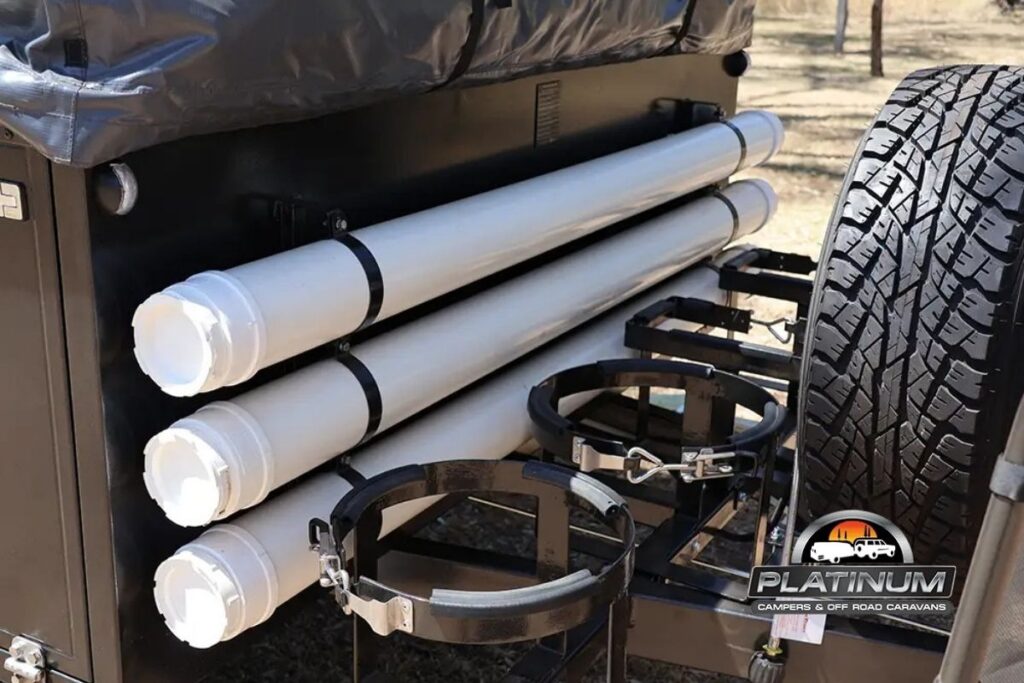
Safety Equipment Verification
Check for required safety equipment including fire extinguishers, smoke detectors, and gas leak detectors where applicable. Verify that all safety devices are current, properly mounted, and functional. Test emergency exits and escape routes for accessibility.
Examine safety chains, breakaway systems, and emergency procedures documentation. Ensure that all occupants can operate essential safety systems and understand emergency procedures. Our essential hitch safety checks guide covers critical safety considerations.
Compliance and Documentation
Verify that the trailer meets Australian Design Rules (ADR) and local registration requirements. Check for appropriate compliance plates, weight ratings, and certification documentation. Ensure that all modifications are properly documented and approved where required.
Review warranty documentation, service records, and any outstanding recalls or service bulletins for the specific model.
Safety and Compliance Checklist
☐ All required safety equipment present and functional
☐ Emergency exits accessible and operational
☐ Safety chains and breakaway systems proper rating
☐ Trailer meets ADR and local requirements
☐ Compliance plates visible and readable
☐ Weight ratings appropriate for intended use
☐ All modifications properly documented
☐ Warranty and service records available
Documentation and Final Verification
Proper documentation ensures legal ownership and provides valuable information about your trailer’s history and specifications. Complete verification protects your investment and provides peace of mind.
Essential Documentation Review
Verify that all ownership documents, registration papers, and compliance certificates are available and accurate. Check service records, warranty information, and any modification documentation. Ensure that insurance requirements can be met and that financing arrangements are clearly understood.
Review the purchase agreement carefully, including any inclusions, exclusions, and after-sales support provisions. Understand your rights regarding returns, warranties, and ongoing support.
Final Inspection Summary
Complete a final walk-around inspection to verify that all systems operate correctly and that any identified issues are properly documented. Take photographs of any concerns and ensure that repair estimates are obtained for significant issues.
Confirm that all included accessories, equipment, and documentation are present before finalizing the purchase.
Documentation Checklist
☐ All ownership documents available and accurate
☐ Registration papers current and transferable
☐ Service records and warranty information complete
☐ Insurance requirements can be met
☐ Purchase agreement clearly understood
☐ All included items present and accounted for
☐ Any issues properly documented with repair estimates
☐ Final inspection completed satisfactorily
Red Flags to Avoid
Certain conditions should immediately raise concerns about a camper trailer’s suitability for purchase. Recognizing these red flags can save you from costly mistakes and safety hazards.
Structural Warning Signs
Avoid trailers with cracked chassis, bent frames, or evidence of major accident damage. Any structural welding repairs should be professionally done with appropriate documentation. Be particularly cautious of rust damage in critical load-bearing areas.
Previous flood damage often appears as water marks, mold, or corrosion in unusual places. Such damage can compromise structural integrity and create ongoing problems with electrical systems and appliances.
Mechanical Concerns
Steer clear of trailers with seized brakes, worn suspension components, or evidence of poor maintenance. Multiple electrical modifications or amateur wiring work often indicate potential reliability issues. Excessive wear on running gear components suggests overloading or inadequate maintenance.
Common Red Flags
☐ Cracked or damaged chassis components
☐ Evidence of flood or major accident damage
☐ Amateur electrical modifications
☐ Seized or inoperative brakes ☐ Excessive rust or corrosion
☐ Multiple patches or repairs to canvas
☐ Missing compliance plates or documentation
☐ Seller reluctant to allow thorough inspection
Questions to Ask Sellers
Asking the right questions provides valuable insight into the trailer’s history, condition, and suitability for your needs. Experienced sellers should readily provide detailed answers about their equipment.
Maintenance and Service History
Inquire about regular maintenance schedules, recent services, and any major repairs or modifications. Ask for documentation of bearing services, brake adjustments, and canvas treatments. Understanding the maintenance history helps predict future service needs and costs.
Find out about storage conditions and usage patterns. Trailers stored outdoors or used frequently may show different wear patterns than those used occasionally and stored under cover. Our camper storage guide explains proper storage practices.
Usage and Performance Questions
Ask about typical towing conditions, maximum distances traveled, and any performance issues experienced. Inquire about fuel consumption impacts, handling characteristics, and setup/pack-down times. Understanding real-world performance helps set appropriate expectations. For first-time towers, our first time towing campers guide provides valuable tips.
Essential Questions for Sellers
☐ What is the complete service and maintenance history?
☐ How has the trailer been stored when not in use?
☐ What modifications or upgrades have been made?
☐ Are there any known issues or upcoming maintenance needs?
☐ What accessories and equipment are included in the sale?
☐ Why is the trailer being sold?
☐ Can you demonstrate all systems and features?
☐ What ongoing support or warranty is available?
Making Your Decision
After completing your inspection, compile all information to make an informed purchase decision. Consider both immediate and long-term costs when evaluating your options.
Cost Evaluation
Factor in the purchase price, immediate repair needs, and ongoing maintenance costs when evaluating value. Compare similar models and current market prices to ensure fair pricing. Include transportation costs, registration fees, and insurance in your total investment calculation. Our best camper trailers under $20,000 guide provides pricing comparisons.
Consider financing options and determine the total cost over the loan period if applicable. Evaluate whether immediate repairs or upgrades fit within your budget and timeline.
Long-term Considerations
Think about how the trailer fits your current and future camping needs. Consider whether the size, features, and capabilities match your intended usage patterns. Evaluate the availability of parts, service support, and potential resale value. Our article on whether camper trailers are still worth it in 2025 discusses long-term value considerations.
Decision Factors
☐ Purchase price fair compared to market value
☐ Immediate repair costs within budget
☐ Trailer meets current and future camping needs
☐ Parts and service support readily available
☐ Overall condition justifies the investment
☐ Seller provides adequate support and documentation
☐ Financing terms acceptable if required
☐ Insurance coverage available at reasonable cost
Frequently Asked Questions
Q: How long should a pre-purchase inspection take?
A: Allow 2-3 hours for a thorough inspection of a used camper trailer. New trailers require less time but still deserve careful attention to ensure all systems operate correctly and specifications meet your needs.
Q: Should I hire a professional for the inspection?
A: Consider professional inspection for expensive trailers or if you lack mechanical experience. Many caravan and camping clubs offer inspection services, or mechanical workshops can provide professional assessments for complex systems.
Q: What’s the most important thing to check on a used camper?
A: Structural integrity is paramount – check the chassis, frame, and mounting points first. Electrical and brake systems are also critical for safety and legal road operation.
Q: How do I know if canvas damage is repairable?
A: Small tears and worn zippers are usually repairable, but extensive mold, multiple patches, or severe UV damage often require complete canvas replacement, which can cost several thousand dollars. Our emergency canvas tent repairs guide covers temporary fixes.
Q: What questions should I ask about warranty coverage?
A: Ask about remaining manufacturer warranty, what components are covered, and whether warranty transfers to new owners. Understand exclusions and maintenance requirements to keep warranty valid. Check our warranty terms and conditions for detailed information.
Q: How do I verify the trailer’s compliance with Australian standards?
A: Check for ADR compliance plates and verify that modifications meet legal requirements. Registration authorities can confirm compliance status and advise on any requirements for transfer.
Q: What should I do if I find problems during inspection?
A: Document all issues with photos and get repair estimates for significant problems. Use this information to negotiate price adjustments or determine if the trailer still represents good value.
Q: How important is service history documentation?
A: Service records indicate responsible ownership and help predict future maintenance needs. Lack of documentation isn’t necessarily disqualifying but may indicate unknown maintenance requirements. Our 5 maintenance tips article explains essential service requirements.
Q: Should I test the trailer on the road before buying?
A: If possible, arrange a road test to evaluate towing characteristics, brake performance, and stability. This provides valuable insight into real-world performance and handling.
Q: What financing options are available for camper trailers?
A: Many dealers offer financing packages, or you can arrange loans through banks, credit unions, or specialized recreational vehicle lenders. Compare interest rates, terms, and conditions to find the best option. Visit our finance page for current options.
Sources
• Australian Design Rules – Department of Infrastructure and Transport
• Caravan Industry Association of Australia – Consumer Guidelines
• Australian Automotive Aftermarket Association – Trailer Safety Standards
• Consumer Affairs Victoria – Buying Used Vehicles Guide
• Queensland Transport – Trailer Registration Requirements
• Insurance Council of Australia – Recreational Vehicle Coverage Guidelines
Explore Our Camper Range
Ready to find your perfect camper trailer? Platinum Campers offers a comprehensive range of Australian-designed and built camper trailers, from entry-level soft floor models like the Cadet SE to premium hard floor units like the Chariot E1 and our innovative Commander Hybrid. Visit our showrooms in Townsville, Rockhampton, Brisbane, or contact us through our locations page to speak with our experienced team about finding the ideal camper for your adventures.


